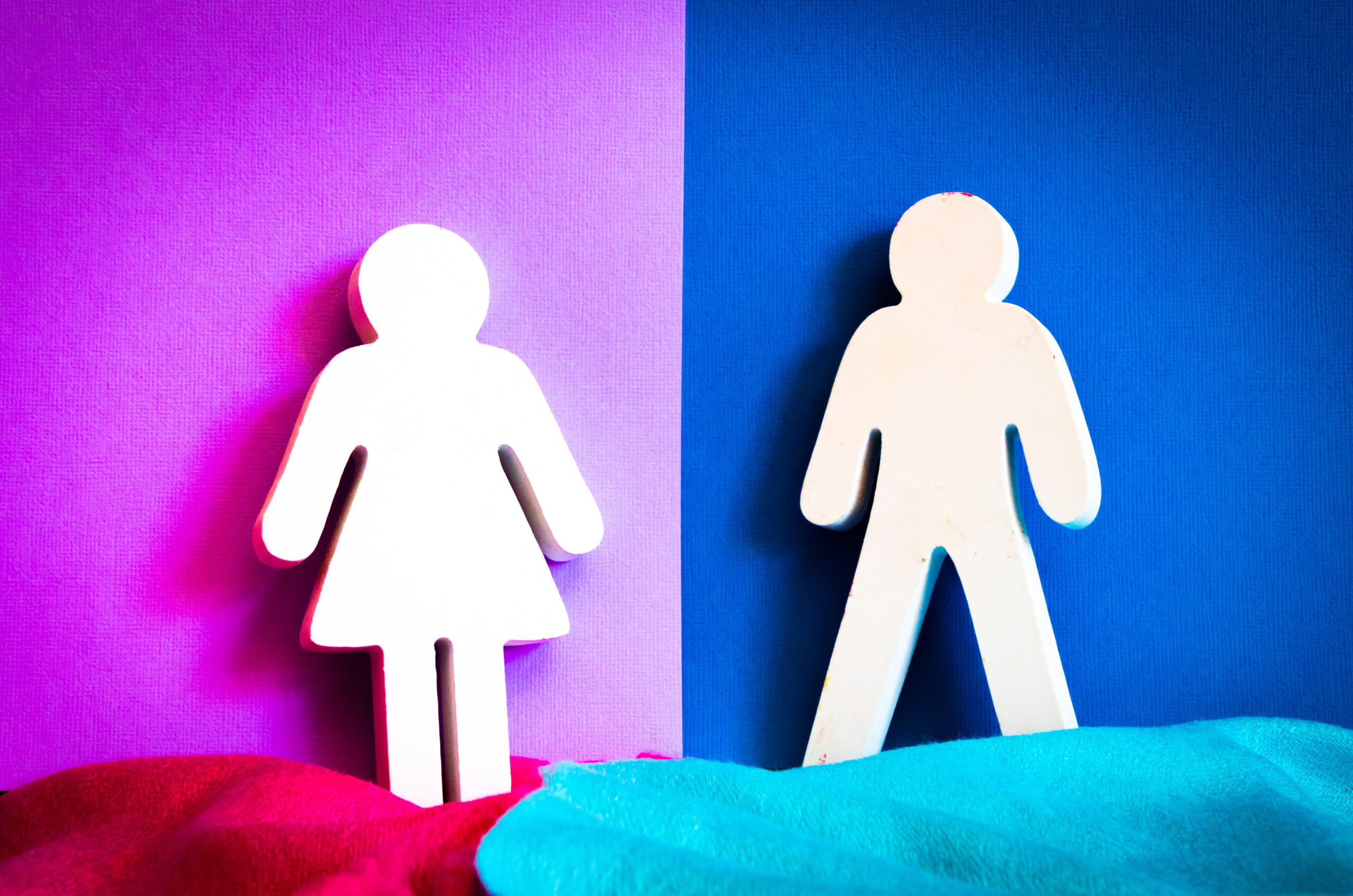
There are many biological differences between men and women. This does not only include physical appearances, but also for instance mental health [1] [2]. For example, whether you are biologically a man or a women can influence your risk of developing a particular mental condition such as depression or ADHD. In this blog I will discuss how differences in biological sex* are linked to differences in the gut microbiome and problem- and prosocial behaviour.
Differences in problem- and prosocial behaviour
Sex differences have not only been found in clinically diagnosed mental disorders, but also in behavioural problem- and prosocial behaviour. Sex differences in problem- and prosocial behaviour mostly surface during developmental stages, especially in adolescence [2][3]. Problem behaviour can be divided into externalising and internalising behaviour. Externalising behaviour is characterized by negative behaviour against others, including aggressive, disruptive and hyperactive behaviour [4][5]. Externalising problems affect 5-10% of adolescents and occur more commonly in boys [4]. In contrast to externalising problems, internalising problems merely affects the individual itself, and not others. Internalising problems are characterized by withdrawn-, anxious-, and depressed behaviour [4][5]. Internalising problems have a prevalence ranging from 12-23% among adolescents and are more common in girls compared to boys [4]. Prosocial behaviour (i.e., behaviour that benefits others) increases during puberty, and this is more pronounced in girls [3].
Differences in gut microbiota
Biological sex does not only impact behavioural problems and prosocial behaviour, but also plays as an influential factor on the gut microbiota community; and this has been discerned in adults. The gut microbiota is a collection of microorganisms, of which the bacteria accounts for the most in the abundance [6][7][8]. Multiple studies have investigated differences in the gut microbiota between men and women in adults. However, these studies have generated inconsistent results [9][10][11][12]. Large cohort studies did show that women in general have more different species in their gut compared to men [9][11]. Whether these sex differences are also present in children and adolescents, is not yet clear [13].
The role of the gut microbiome in behaviour
The gut microbiota could in turn also have an effect on problem- and prosocial behaviour through communication via the microbiota gut brain axis. This is a bidirectional communication pathway between the gut microbiota and the brain [7][14][15]. The microbiota gut brain axis has been associated with different neuropsychiatric disorders, such as depression, anxiety and ADHD, which share common symptoms with behavioural problems [16][17][18][19][20][21]. This indicates that the gut microbiota might also play a role in behavioural problems.
Currently, I am involved in a study where we explore how the gut microbiota differs between boys and girls. Secondly, we investigate the association between problem- and prosocial behaviours and the gut microbiota, as well as the differences in these associations between boys and girls. Exploring the role of the gut microbiota on these behaviours could broaden the understandings of the gut-brain axis in pubertal children and may help develop new (therapeutic) interventions for problem behaviour at this age. This may prevent potential negative consequences of problem behaviour later in life.
However, as promising as this may sound, we still have to think critically about our results. For example, associations found in this study do not directly imply that the gut bacteria are causing a certain type of behaviour. There may be another factor that causes both differences in gut bacteria and certain behaviour, or the associations may be due to chance. Therefore, more studies focused on mechanisms and causality between gut bacteria and behaviour are also needed. It should also be stressed that differences between men and women, both in terms of behaviour and gut microbiome, are generally very small. Nonetheless, it’s important to investigate sex differences, because they can help up to better understand the biology underlying our behaviour.
*Note:Biological sex is defined here as the condition of being male or female, which is determined by a person’s chromosomes, and is identified at birth by a person’s anatomy.
References
1. Martel, M.M., Sexual selection and sex differences in the prevalence of childhood externalizing and adolescent internalizing disorders. Psychological Bulletin, 2013. 139(6): p. 1221.
2. Biondo, F., et al., Sex differences in neural correlates of common psychopathological symptoms in early adolescence. Psychological Medicine, 2021: p. 1-11.
3. Fabes, R.A., et al., Early Adolescence and Prosocial/Moral Behavior I:: The Role of Individual Processes. The Journal of Early Adolescence, 1999. 19(1): p. 5-16.
4. Herpertz-Dahlmann, B., K. Bühren, and H. Remschmidt, Growing up is hard: mental disorders in adolescence. Deutsches Arzteblatt international, 2013. 110(25): p. 432-440.
5. Liu, J., Childhood externalizing behavior: theory and implications. Journal of child and adolescent psychiatric nursing : official publication of the Association of Child and Adolescent Psychiatric Nurses, Inc, 2004. 17(3): p. 93-103.
6. Jaggar, M., et al., You’ve got male: Sex and the microbiota-gut-brain axis across the lifespan. Frontiers in Neuroendocrinology, 2020. 56: p. 100815.
7. Morais, L.H., H.L. Schreiber, and S.K. Mazmanian, The gut microbiota–brain axis in behaviour and brain disorders. Nature Reviews Microbiology, 2021. 19(4): p. 241-255.
8. Sender, R., S. Fuchs, and R. Milo, Revised Estimates for the Number of Human and Bacteria Cells in the Body. PLoS Biol, 2016. 14(8): p. e1002533.
9. de la Cuesta-Zuluaga, J., et al., Age- and Sex-Dependent Patterns of Gut Microbial Diversity in Human Adults. mSystems. 4(4): p. e00261-19.
10. Ding, T. and P.D. Schloss, Dynamics and associations of microbial community types across the human body. Nature, 2014. 509(7500): p. 357-360.
11. Falony, G., et al., Population-level analysis of gut microbiome variation. Science, 2016. 352(6285): p. 560-4.
12. Mueller, S., et al., Differences in Fecal Microbiota in Different European Study Populations in Relation to Age, Gender, and Country: a Cross-Sectional Study. Applied and Environmental Microbiology, 2006. 72(2): p. 1027-1033.
13. Kim, Y.S., et al., Sex Differences in Gut Microbiota. The world journal of men’s health, 2020. 38(1): p. 48-60.
14. Collins, S.M., M. Surette, and P. Bercik, The interplay between the intestinal microbiota and the brain. Nature Reviews Microbiology, 2012. 10(11): p. 735-742.
15. Settanni, C.R., et al., Gastrointestinal involvement of autism spectrum disorder: focus on gut microbiota. Expert Review of Gastroenterology & Hepatology, 2021. 15(6): p. 599-622.
16. Jiang, H., et al., Altered fecal microbiota composition in patients with major depressive disorder. Brain, Behavior, and Immunity, 2015. 48: p. 186-194.
17. Kelly, J.R., et al., Transferring the blues: Depression-associated gut microbiota induces neurobehavioural changes in the rat. Journal of Psychiatric Research, 2016. 82: p. 109-118.
18. Mathee, K., et al., The gut microbiome and neuropsychiatric disorders: implications for attention deficit hyperactivity disorder (ADHD). Journal of medical microbiology, 2020. 69(1): p. 14-24.
19. Zheng, P., et al., Gut microbiome remodeling induces depressive-like behaviors through a pathway mediated by the host’s metabolism. Molecular Psychiatry, 2016. 21(6): p. 786-796.
20. Johnson, K.V.A., Gut microbiome composition and diversity are related to human personality traits. Human Microbiome Journal, 2020. 15: p. 100069.
21. Richarte, V., et al., Gut microbiota signature in treatment-naïve attention-deficit/hyperactivity disorder. Translational Psychiatry, 2021. 11(1): p. 382.
